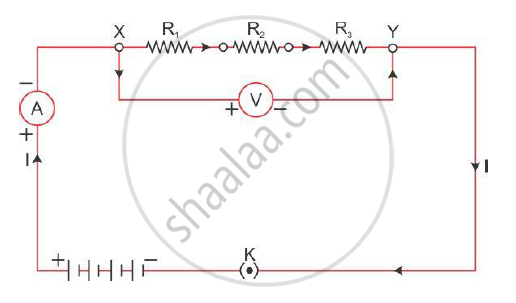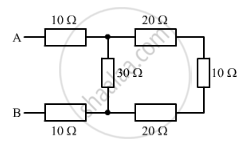Advertisements
Advertisements
Question
Find the expression for resistors connected in series.
Solution
When two or more resistors are joined from end to end, the resistances are connected in series.

The current in series remains the same across all the resistors.
The potential difference is the sum of potential differences across all the individual resistors.
V = V1 + V2 + V3 … (1)
Let I be the current in the circuit.
On applying Ohm’s law to the entire circuit, we get
V = IRs … (2)
Here, Rs is the combined resistance of the circuit.
Now, applying Ohm’s law to individual resistances, we get
V1 = IR1
V2 = IR2
V3 = IR3 ......(3)
From equations (1), (2) and (3), we get
IRs = IR1 + IR2 + IR3
∴ Rs = R1 + R2 + R3
Here, Rs is the resultant resistance. Thus, the resultant resistance of a series combination of resistors is the sum of individual resistances.
The resultant resistance is greater than all the resistances.
APPEARS IN
RELATED QUESTIONS
Find the expression for the resistors connected in series and write the two characteristics of it. (Draw figure).
Judge the equivalent resistance when the following are connected in parallel − (a) 1 Ω and 106Ω, (b) 1 Ω and 103Ω and 106Ω.
A battery of 9 V is connected in series with resistors of 0.2 Ω, 0.3 Ω, 0.4 Ω, 0.5 Ω and 12 Ω, respectively. How much current would flow through the 12 Ω resistor?
Two resistors of 4Ω and 6 Ω are connected in parallel to a cell to draw 0.5 A current from the cell.
(i) Draw a labelled circuit diagram showing the above arrangement.
(ii) Calculate the current in each resistor. What is an Ohmic resistor?
A p.d. of 4 V is applied to two resistors of 6 Ω and 2 Ω connected in series. Calculate:
(a) the combined resistance
(b) the current flowing
(c) the p.d. across the 6 Ω resistor
What is (a) highest, and (b)Ω lowest, resistance which can be obtained by combining four resistors having the following resistances?
4 Ω, 8 Ω, 12 Ω, 24 Ω

State how are the two resistors joined with a battery when same current flows in each resistor.
In series combination of resistances ______.
You have three resistors of values 2 `Omega`, 3 `Omega`, and 5 `Omega`. How will you join them so that the total resistance is less than 2 `Omega`?
Choose the correct alternative and rewrite the following:
You are given three equal resistances. In how many combinations can they are arranged?
How does the resistance of an alloy, vary with temperature?
Write an expression for the resistance of a conducting wire in terms of its length and area of cross-section.
2Ω resistor A, 1Ω resistor B and 4Ω resistor C are connected in parallel. The combination is connected across a 2V battery of negligible resistance. Draw the diagram of the arrangement and calculate:
(i) The current in each resistor A and C,
(ii) The current through battery.
Illustrate-combination of cells e.g., three cells, in series, explaining the combination briefly. Obtain an expression for current ‘i’ in the combination.
What should be the length of a nickel wire of area of cross-section 3 mm2 used for making a rheostat of 750 ohm? (ρ of nickle = 0.069 Ohm mm2/m)
The resistance of the hot filament of the bulb is about 10 times the cold resistance. What will be the resistance of 100 W-220 V lamps, when not in use?
What is the maximum resistance which can be made using five resistors each of `1/5` W?
